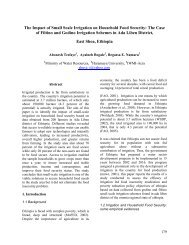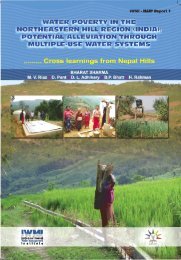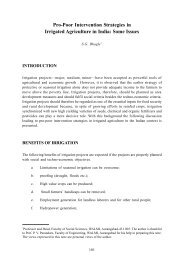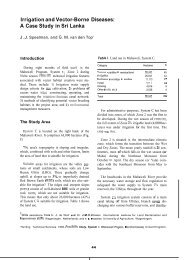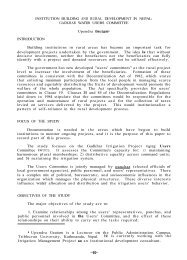A Case Study from System H, Sri Lanka
A Case Study from System H, Sri Lanka
A Case Study from System H, Sri Lanka
- No tags were found...
Create successful ePaper yourself
Turn your PDF publications into a flip-book with our unique Google optimized e-Paper software.
ForewordA moa SHARB of <strong>Sri</strong> <strong>Lanka</strong>’s investment in the agricultural sector since independence in 1948 has been on irrigatedsettlement projects in the sparsely settled dry zone of the country. This included the restoration of nearly all ancientabandoned major irrigation reservoir schemes, as well as the construction of new major multipurpose projects. By theearly 1960s most of the ancient major works had been restored and settled by farmers under the category of ‘ColonizationSchemes.’Under the category of ‘Major Multipurpose Projects.’ the fmst was the Gal Oya Project, which commenced in 1949under the auspices of the Gal Oya Development Board. This functioned as an Area Authority that was responsible forintegrated multipurpose developmen$ its main focus was on construction and farmer settlement. No serious attemptswere made to develop appropriate irrigation management institutions and practices in either of these major projects orcolonization schemes until the mid-1970s. Water delivery values in excess of 1.82 hectare-me-ectare (6 acre-feedacre) ex sluice for mnhu (wet season) rice cultivation were not uncommon in most irrigation schemes.Opportunities for serious attempts to optimize the use of irrigation supply were afforded under the auspices of theMahaweli Development Board (MDB) which was set up in 1970 to carry out the integrated development of <strong>System</strong> H(43,000 hectare [ha]) of the Mahaweli multipurpose project. The MDB was subsequently superceded by the MahaweliAuthority of <strong>Sri</strong> <strong>Lanka</strong> (MASL) in 1979 to undertake the accelerated development of approximately 100,OOO ha of newland which covered four major systems, of which <strong>System</strong> H was one. Under the auspices of the Mahaweli EconomicAgency (MEA), which is the management arm of the MASL, a unified management model was established for <strong>System</strong>H where a high degreeof institutional coordination &?d cooperation was envisaged. This contrasted with the previousMDB type of management and the line agency management style of the earlier colonization schemes.<strong>System</strong> His made up of 12 subsystems of which 6 are new settlement areas while the rest fall within older colonizationschemes. Subsystem H5 (5,000 ha) is located at the tail end of <strong>System</strong> H and was the last H subsystem to be developed,around 1980-82. In common with the other subsystems, H5 has been provided with adequate facilities in respect ofirrigation and social infrastructure as compared with earlier irrigation schemes. The real challenge which faced themanagement agency was how to utilize properly this infra structure for achieving a high standard of water management.This was of special significance not only because H5 area is located in the tail end of <strong>System</strong> H, but also because <strong>System</strong>Has a whole has an inadequate irrigation supply during yulu (dry season).The International Jnigation Management Institute (IIMI) commenced its studies on Irrigation Management forDiversified Cropping in yulu 1985 in the Kalankuttiya Block of subsystem H2. The research objectives were focused onan examination of the technical and socio-economic constraints to more intensive diversified cropping during yala. Oneof the more important conclusions that emerged in the fmt phase of IIMI’s studies was that there was an urgent need toimprove the interaction between irrigation staff and farmers in irrigation system management <strong>from</strong> planning andimplementation to monitoring of irrigation deliveries. It was clearly recognized that closer coordination between agencyand farmers is needed to meet the more demanding requirements for non-rice crops during yula in situations of limitedand uncertain water supply.In the second phase of IIMI’s studies in yuiu 1987 when IIMI was working with the agency to pilot-test some watermanagement innovations, its attention was drawn to a preliminary draft report prep& by Mr. P. Weerakkody, ProjectIrrigation Engineer of H5. then stationed at the Nochchiyagama Project Office. This draft report described the steps thatwere taken towards a successful implementation of a coordinated participatory approach to water management in the H5subsystem. Recognizing the significant complementarity between what Mr. Weerakkody had already implemented inxiii



